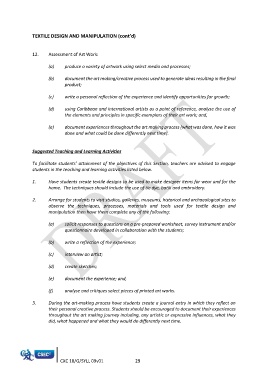Page 1430 - SUBSEC October 2017_Neat
P. 1430
TEXTILE DESIGN AND MANIPULATION (cont’d)
12. Assessment of Art Work:
(a) produce a variety of artwork using select media and processes;
(b) document the art making/creative process used to generate ideas resulting in the final
product;
(c) write a personal reflection of the experience and identify opportunities for growth;
(d) using Caribbean and international artists as a point of reference, analyse the use of
the elements and principles in specific exemplars of their art work; and,
(e) document experiences throughout the art making process (what was done, how it was
done and what could be done differently next time).
Suggested Teaching and Learning Activities
To facilitate students’ attainment of the objectives of this Section, teachers are advised to engage
students in the teaching and learning activities listed below.
1. Have students create textile designs to be used to make designer items for wear and for the
home. The techniques should include the use of tie dye, batik and embroidery.
2. Arrange for students to visit studios, galleries, museums, historical and archaeological sites to
observe the techniques, processes, materials and tools used for textile design and
manipulation then have them complete any of the following:
(a) solicit responses to questions on a pre-prepared worksheet, survey instrument and/or
questionnaire developed in collaboration with the students;
(b) write a reflection of the experience;
(c) interview an artist;
(d) create sketches;
(e) document the experience; and,
(f) analyse and critiques select pieces of printed art works.
3. During the art-making process have students create a journal entry in which they reflect on
their personal creative process. Students should be encouraged to document their experiences
throughout the art making journey including, any artistic or expressive influences, what they
did, what happened and what they would do differently next time.
CXC 18/G/SYLL 09v01 29

